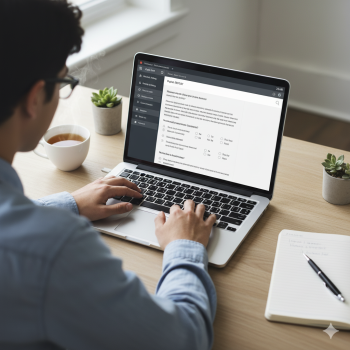Why a Quiet Study Zone Changes Everything for Digital SAT Prep
Imagine sitting down for a full-length Digital SAT practice test and feeling calm, focused, and able to translate weeks of study into steady performance. That outcome often starts well before you open the Bluebook app — it starts in the space where you study. A thoughtfully arranged quiet study zone reduces distractions, builds good habits, and makes your practice sessions more productive. This is where confidence grows, especially for a digital, adaptive exam that rewards consistent strategy and mental stamina.

Who this guide is for
Students and parents who want a realistic, actionable plan for turning a corner of the home into a high-performance study zone for the Digital SAT. Whether you have a quiet bedroom, a corner of the living room, or need to carve out space at the kitchen table, these tips are adaptable and practical. We’ll cover physical layout, schedule-making, tech readiness, test simulations, and how personalized help — like Sparkl’s 1-on-1 guidance and tailored study plans — can amplify your work.
Start with a Simple Philosophy: Function Over Fancy
You don’t need an elaborate office. The best study zone is one that supports focus, comfort, and consistent practice. Think about three core needs:
- Focus: Minimize noise and interruptions.
- Comfort: Support good posture and avoid fatigue.
- Function: Have the right tools — device, charging, timer, scratch paper, and a quiet place to think.
Quick checklist to evaluate a potential study spot
- Can you close a door or create a visual boundary?
- Is natural light available, and can you control glare on your device?
- Is the Wi-Fi stable if you need it for practice sessions (but remember the actual Digital SAT testing app may not require internet during the test)?
- Is there a way to mute household noise — door closed, headphones, or a ‘do not disturb’ signal?
Step-by-Step Room/Corner Setup
Below is a straightforward sequence you can follow. Each step is small, but together they create a robust study environment.
1. Pick the right spot
Choose a location with the fewest predictable interruptions. Bedrooms often work well; if you share a room, consider a partition or a visual cue that signals you’re studying (a sign, a flag, or a lamp set to a particular color).
2. Desk and chair: invest wisely
You don’t need an expensive ergonomic chair, but avoid slouching furniture. A supportive chair and a desk at the correct height reduce fatigue on full-length practice tests.
3. Lighting and visual comfort
Natural light is best, but avoid glare. Add a desk lamp with adjustable brightness and color temperature. Cooler white light is energizing for focused study; warmer tones are useful for evening review sessions.
4. Organize study materials
Have these at hand:
- Device (laptop/tablet) fully charged and configured for practice.
- Bluebook practice tests or official Digital SAT practice materials loaded well before a timed run.
- Scratch paper, pencils, highlighters, and a simple timer or a phone on Do Not Disturb (set to airplane mode if you’re mimicking test conditions).
- A small whiteboard or notepad for problem strategies, formulas, and pacing reminders.
5. Sound control
Noise-cancelling headphones are excellent, but if they’re not available, consider a white noise machine or an app that produces low-level ambient sound. Consistent, low-level sound can be less disruptive than sudden household noises.
Technology and Digital SAT: Be Ready, Not Frantic
Because the SAT you’ll face is digital, technology readiness matters as much as physical space. Practicing on a device similar to the one you’ll use on test day reduces surprises and anxiety.
Device checklist for practice
- Install and test the official practice environment early. Run a practice session at least two weeks before your scheduled test date.
- Keep chargers and a power strip close by. For full-length practice tests, your device should be at 100% or plugged in.
- Close unnecessary tabs and apps that may distract or slow your device during a timed run.
Simulate test conditions
To build stamina and familiarity with the adaptive format, take at least three full-length practice tests under test-like conditions: timed sections, breaks, and on the same device. Treat these practice runs like real test days. This trains resilience and helps with timing, which is often the biggest difference between practice scores and test-day performance.
Design a Realistic, Sustainable Study Schedule
Study quality beats quantity. A consistent plan with shorter, focused blocks tends to trump irregular long sessions. Here’s a simple way to structure weekly prep that fits around school and activities.
| Time Available (weekly) | Suggested Structure | Goal |
|---|---|---|
| 2–4 hours | 3 sessions × 45–60 min | Target weak topics, short drills, and one practice section |
| 5–8 hours | 4–6 sessions × 60–90 min | Content review, practice sections, targeted skills, weekend full-length section |
| 9–15 hours | Daily study with two longer weekend sessions | Multiple full-length practice tests, timed strategies, polishing weak areas |
Weekly micro-routine example
- Monday: 1 hour — focused grammar/readiness drills.
- Wednesday: 1.5 hours — math concept practice and pacing drills.
- Friday: 1 hour — vocabulary in context, reading passages.
- Saturday: 2–3 hours — one full practice section + review.
- Sunday: 2–3 hours (biweekly) — full-length Digital SAT practice test under simulated conditions.
Make It Feel Official: Rituals and Signals
Our brains respond to ritual. Small, consistent cues help shift into study mode quickly and shut down afterward so you don’t burn out.
Try a short pre-study ritual
- Turn on the desk lamp and put your phone on Do Not Disturb (or airplane mode) and place it face-down in another room.
- Open your Bluebook practice test or set up your timer for the session length.
- Write one clear goal on your whiteboard: “Complete one reading passage with accuracy focus” or “Finish 10 algebra problems under timed conditions.”
End-of-session checklist
- Log what you practiced and one insight (example: “I lost time on multi-step algebra; need to practice isolation techniques”).
- Set the next session’s goal — this reduces friction for the next study block.
Family and House Rules: Make Support Practical
Parents can be tremendous allies. Agree to simple, enforceable rules so the study zone preserves quiet blocks. A short, posted schedule and a “studio light” (lamp on = do not disturb) can communicate more effectively than repeated reminders.
Sample household agreement
- Weeknights 7:00–8:30 PM: Quiet study time (no TV, low-volume activities elsewhere).
- Weekend mornings 9:00–12:00: Full practice test windows (minimal interruptions).
- Emergency exceptions only — discuss what qualifies as an emergency.
Use Practice Data to Improve the Space and Strategy
Track what interrupts you during practice tests. Is it a noisy sibling? A cluttered desk? Tech problems? Keep a “distraction log” for two weeks and use it to refine your setup. Your study zone should evolve as your prep intensifies.
Example distraction log (three entries)
- Entry 1: 10:15 AM — neighbor’s lawnmower; used noise-cancelling headphones next session.
- Entry 2: 2:30 PM — phone alert; turned off notifications and left phone outside study zone.
- Entry 3: 11:45 AM — glare on screen; rearranged desk orientation relative to window.
Smart Tools and Materials for the Digital SAT Study Zone
Equip your zone with a small, focused set of tools rather than a pile of resources you never use. Keep the essentials visible and everything else stored out of sight to reduce decision fatigue.
- Official practice tests and practice protocols (timed sections, scoring method).
- Timer that supports interval training (pomodoro-style blocks work well for review sessions).
- Index cards for vocab or quick math formulas.
- Whiteboard for working through long problems and visual pacing cues.
- Comfort items: water bottle, stress ball, blue-light filter for evening sessions.
How Personalized Tutoring Fits Naturally Into Your Study Zone
Even the best study space benefits from personalized guidance. A tutor can help you identify weak points, suggest efficient practice strategies, and hold you accountable for the plan you set up. If you’re working with a 1-on-1 tutor such as those provided by Sparkl, your study zone becomes the place where tailored feedback and AI-driven insights meet deliberate practice.
Ways a tutor can enhance your home study zone
- Customized study plan that uses your practice-test diagnostics to target weaknesses.
- One-on-one sessions that model how to use the study zone for specific tasks (timed sections, pacing strategies, and review techniques).
- Expert tips on how to run effective practice tests and interpret digital adaptive behavior.
Practical Examples and Mini Case Studies
Here are two realistic student scenarios that show how small changes to a study zone made a measurable difference.
Case A: Mia — the busy junior
Mia studied in a noisy living room and rarely finished practice sections. After moving to a corner of her bedroom, using a desk lamp as a signal for no interruptions, and practicing twice a week under timed conditions, her section score consistency improved. The change: fewer interruptions and better simulation of test conditions.
Case B: Jamal — the tough-timed math student
Jamal had correct answers but ran out of time during math. He added a pacing board (a whiteboard with time checkpoints for each question cluster) to his study zone and practiced with a tutor who guided him through time-saving algebraic strategies. Two months later, Jamal’s section pace improved and his practice-test scores rose by several points.
Final Weeks Before Test Day: Simulation and Calm
In the final two weeks, transition your study zone into a true rehearsal space. Run full-length practice tests on the same device you’ll use on test day, take breaks exactly as scheduled, and do your test-day rituals. This prevents last-minute surprises and reduces test anxiety.
48–72 hours before test day
- Run one final practice test if it helps your confidence, but don’t overdo it — rest matters.
- Pack your test-day bag and lay it out in the study zone so nothing is forgotten (charger, approved ID copies, snacks for breaks).
- Practice sleep hygiene: keep consistent bedtimes and avoid late-night cramming.
One Last Table: Quick Reference—Create Your Ideal Study Zone in a Weekend
| Day | Action | Outcome |
|---|---|---|
| Day 1 (Morning) | Pick spot, move desk/chair, test lighting | Functional workspace chosen |
| Day 1 (Afternoon) | Set up device and chargers, install practice materials, test Bluebook/practice tests | Tech readiness confirmed |
| Day 2 | Organize materials, set household rules, do a short practice section | Routine established, first data point collected |
| Day 3 | Run a timed practice test or full section, log distractions, refine setup | Refinements made for longer sessions |
Closing Thoughts: Build a Space That Builds You
Creating a quiet study zone for the Digital SAT is more than interior design — it’s a deliberate act of shaping the conditions where good habits take hold. Small, consistent improvements to your environment, schedule, and technology setup can add up to meaningful score gains. Keep your space simple, adaptive, and supportive of practice that mimics test-day conditions.
Finally, remember that you don’t have to do it all alone. Personalized tutoring — like the focused, one-on-one guidance and tailored study plans offered by Sparkl — can plug into your study zone and accelerate your progress by helping you practice smarter, not just harder. The space you build at home becomes the launchpad for your best test-day performance.

Ready to start?
Pick one small change and make it today: move the phone to another room during study blocks, add a lamp as a study-signal, or schedule a 45-minute timed practice section this weekend. Those small, repeatable actions create momentum. Your quiet study zone is a place where effort meets calm — and that combination is the secret sauce behind steady Digital SAT improvement.
Good luck, and remember: a great study zone is built one intentional habit at a time.

















No Comments
Leave a comment Cancel